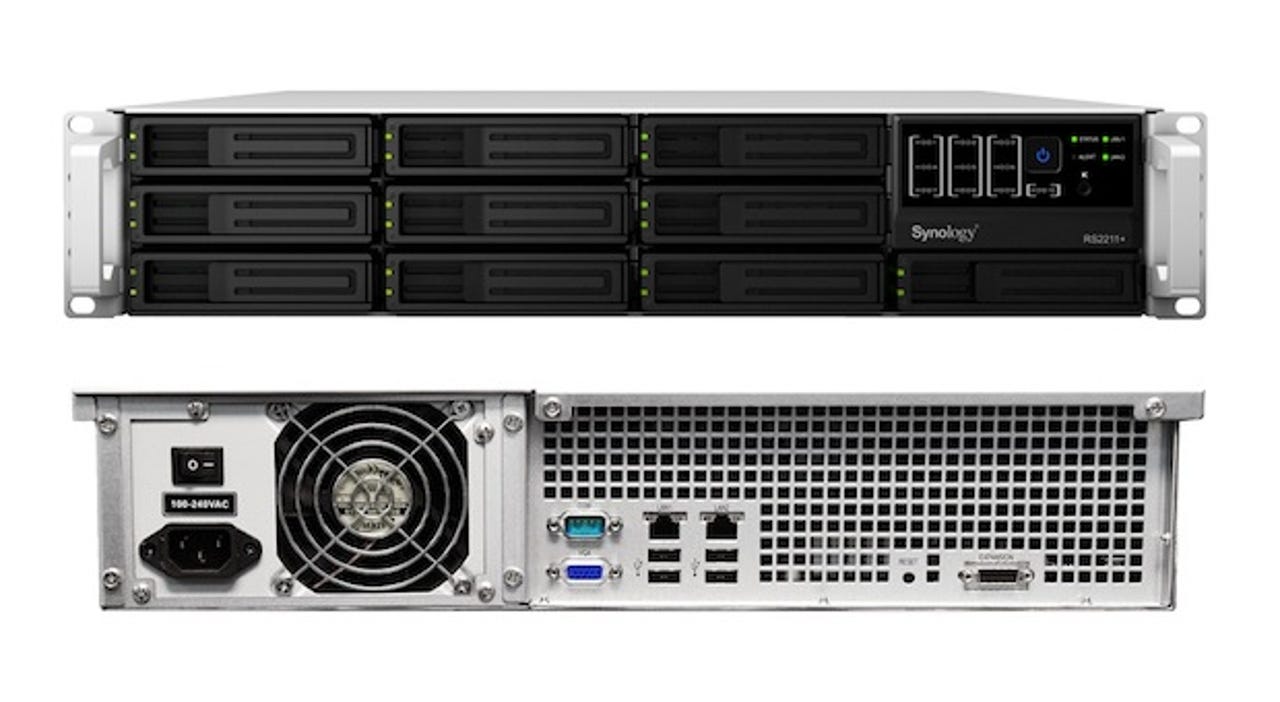Synology RackStation RS2211+

Synology RackStation RS2211+

With its highly scalable RackStation RS2211+, NAS vendor Synology is clearly looking to move upmarket from its small-business heartland. Enterprises may be attracted by the 66TB of RAID-protected storage on offer, and support for the same add-on SME features found on other Synology appliances is another advantage. However, the RackStation RS2211+ lacks options that some enterprise customers may be looking for.
First impressions are good, with the RS2211+ housed in a smart 2U metal chassis and fitted with a couple of big, shiny, pull handles for ease of mounting in an equipment rack. No sliding rails were supplied with the review unit, but these are listed as an accessory. Similarly, our sample only had one power supply — a version with redundant power supplies (the RS2211RP+) sells for £1,425 (ex. VAT). Neither model has hot-swap fans.
The RackStation RS2211+ has 10 hot-plug drive bays that can take 3.5in. or 2.5in. SATA drives; a model with redundant power supplies is available, and there's an optional 12-bay expansion unit too
A lift-off lid gives access to the internals. Unfortunately it's secured by a couple of screws, but you're unlikely to need to take it off that often, other than to change a faulty fan or plug more memory into the tiny motherboard located inside the unit. Powered by a 1.8GHz dual-core Atom processor, the RackStation RS2211+ comes with 1GB of memory as standard, upgradeable to 3GB using an ordinary SODIMM module.
The other main components — the disks — simply slide in from the front, with ten hot-plug bays provided. Each has a carrier into which the disks are mounted using screws provided, but there's no way of locking the disks in place.
We opted to use a set of 3.5in. 2TB disks which we had lying around, but pretty much any SATA disk can be used — and with two sets of screw holes drilled into the carriers, the Synology appliance can take 2.5in. disks as well. Indeed, there's nothing to stop you mixing disk sizes, capacities and spin speeds, although the recommendation is to go for a matched set to get the best possible performance and capacity.
According to Synology the maximum disk capacity is 3TB, although this may change as bigger drives become available. For now, however, that gives a limit of 30TB, which sounds quite a lot but may not be enough for some customers. Fortunately there's an optional add-on expansion unit that accommodates a further 12 disks, giving a whopping 66TB of internal storage in total.
Housed in a similar 2U rack-mount chassis, two implementations of the expansion unit are available, one with a single power supply, the other with redundant power. The single powered unit (the RX1211) costs £817 (ex. VAT), while the redundant power model (the RX1211RP) sells for £1,217 (ex. VAT).
Connectivity to the expansion unit is via an Infiniband interface, for which Synology claims a maximum throughput of 12Gbps. That's 1Gbps of bandwidth per disk slot, which could put a cap on performance — if only on densely populated and highly stressed systems. A lack of support for the latest Rev 3 SATA (6Gbps) disks could also have an effect here, although again only when the system is under load.
As well as the Infiniband port there are a couple of Gigabit Ethernet interfaces for LAN connectivity with built-in support for load balancing and automatic failover, plus four USB ports. The latter can be used to share printers and to attach extra disks, but these can't be included in an array. Plus you're limited to USB 2.0 speeds here, so external disks are unlikely to be used for anything other than backup. To this end, tools to backup and restore the shared storage are also included as part of the Synology package. However, these are fairly basic — there's no instant snapshot facility, for example.
The RS2211+ is driven by Synology's Linux-based DiskStation Manager OS
As with other Synology appliances we've tested, the RS2211+ is driven by the Linux-based DSM (Disk Station Manager) software. It's also installed in exactly the same way, via a Windows-based loader that copies the OS onto a bootable partition on the unit. This takes a few minutes to go about its business, after which you connect to and manage the appliance via a browser.
The interface is pretty intuitive, with a desktop-like GUI in the latest DSM 3.1 implementation plus support for multitasking, which is pretty unusual on an affordable NAS appliance.
Disk Station Manger offers plenty of RAID options, including Synology Hybrid RAID (SHR), which lets you mix different disk capacities
One of the first tasks is, naturally, to sort out the storage: there are lots of options to configure RAID storage arrays, including the use of Synology's own SHR (Synology Hybrid RAID) technology. Much like BeyondRAID on Drobo appliances, this lets you configure arrays made up of different disk capacities, although industry-standard RAID 1-6 configurations are also supported, with online expansion and hot sparing other key options.
It can take a while to build an array or convert from one type to another, but that's standard for this type of storage appliance. For our tests we simply left the SHR technology to get on with it, and then created a volume to be shared on our Windows test network.
Interestingly the volumes created aren't tied to the underlying RAID setup so you can increase capacity very quickly — assuming, of course, that the physical space is available. Moreover, although volumes can be shared on mixed Windows, Apple Mac and Linux/Unix networks, the underlying file system is EXT4, which is very robust and in theory can support volume sizes of up to 1 exabyte (1 million terabytes).
Performance will depend on lots of factors, including the type of disks and RAID configuration chosen, plus whether you opt for NAS sharing or take advantage of the built-in iSCSI support. The amount of memory installed will also have a bearing, especially when servicing a large number of users. You could even go for fast SSD (Solid-State Disk) drives, although the cost involved could make that prohibitive.
To get a feel for what the RS2211+ can do, we tested using basic NAS access from a single Windows PC connected using Gigabit Ethernet. Average read throughput was 140MB/s on this setup, with an average of 110MB/s on writes. That's not quite up to the claimed 198MB/s and 166MB/, but it's respectable for a NAS appliance in this price bracket.
Bear in mind also that the Synology software provides a lot more beyond basic network file sharing. There are built-in web, FTP and database servers plus email and media servers; you can also monitor IP cameras from the DSM console and a lot more besides. All of this should appeal to small businesses looking for an easy-to-manage alternative to a general-purpose server.
At the other end of the scale, however, the RS2211+ is nudging into low-end SAN territory where extra features such as these are of little value. For enterprises, it's all about the storage — and unfortunately there are few things missing, such as thin provisioning (where storage is only allocated as required), plus built-in snapshotting and deduplication facilities.
Still, that's not surprising given the price, and the balance of options is about right to appeal to the widest possible audience. That said, the emphasis is on servicing the needs of the smaller, budget-conscious, organisation.